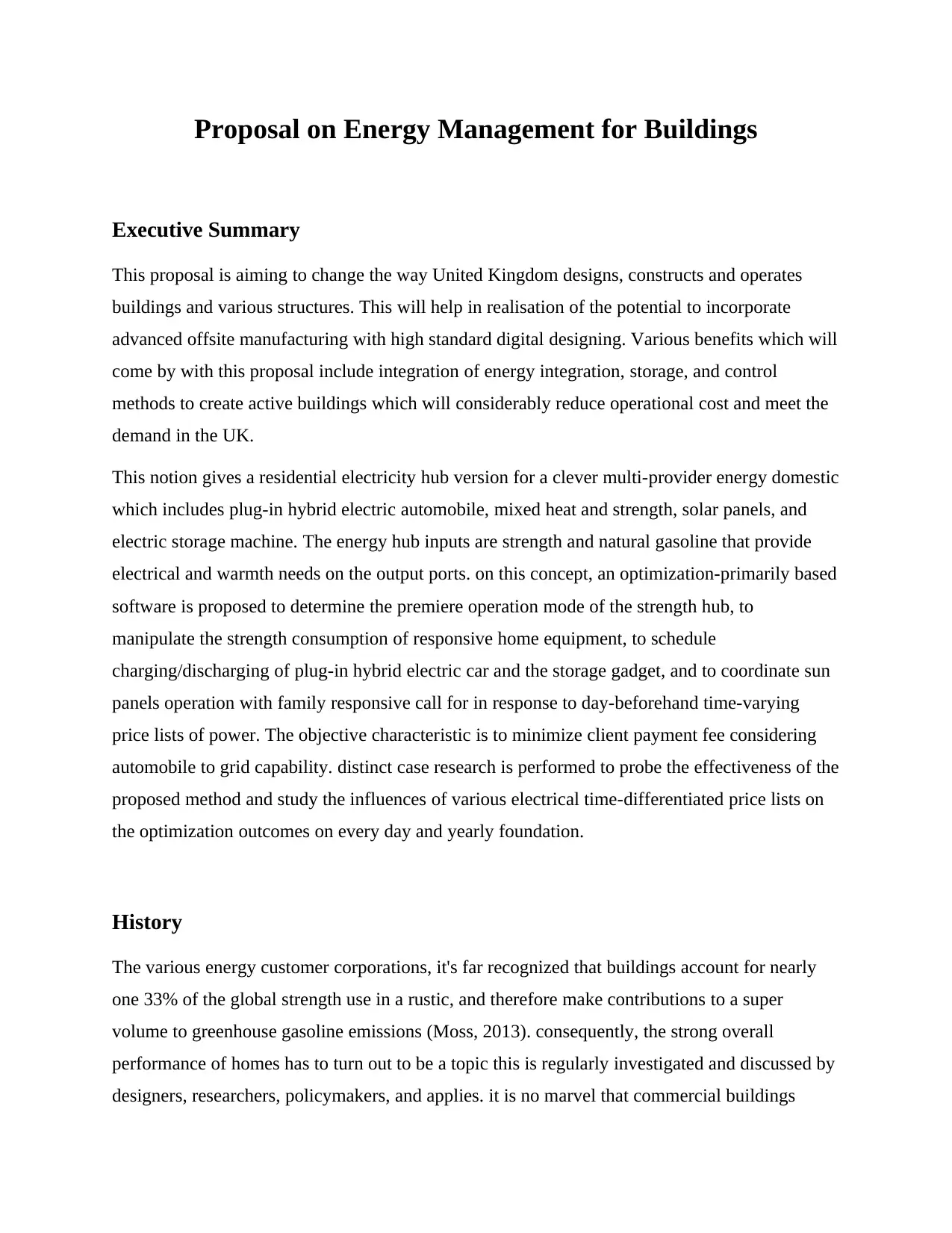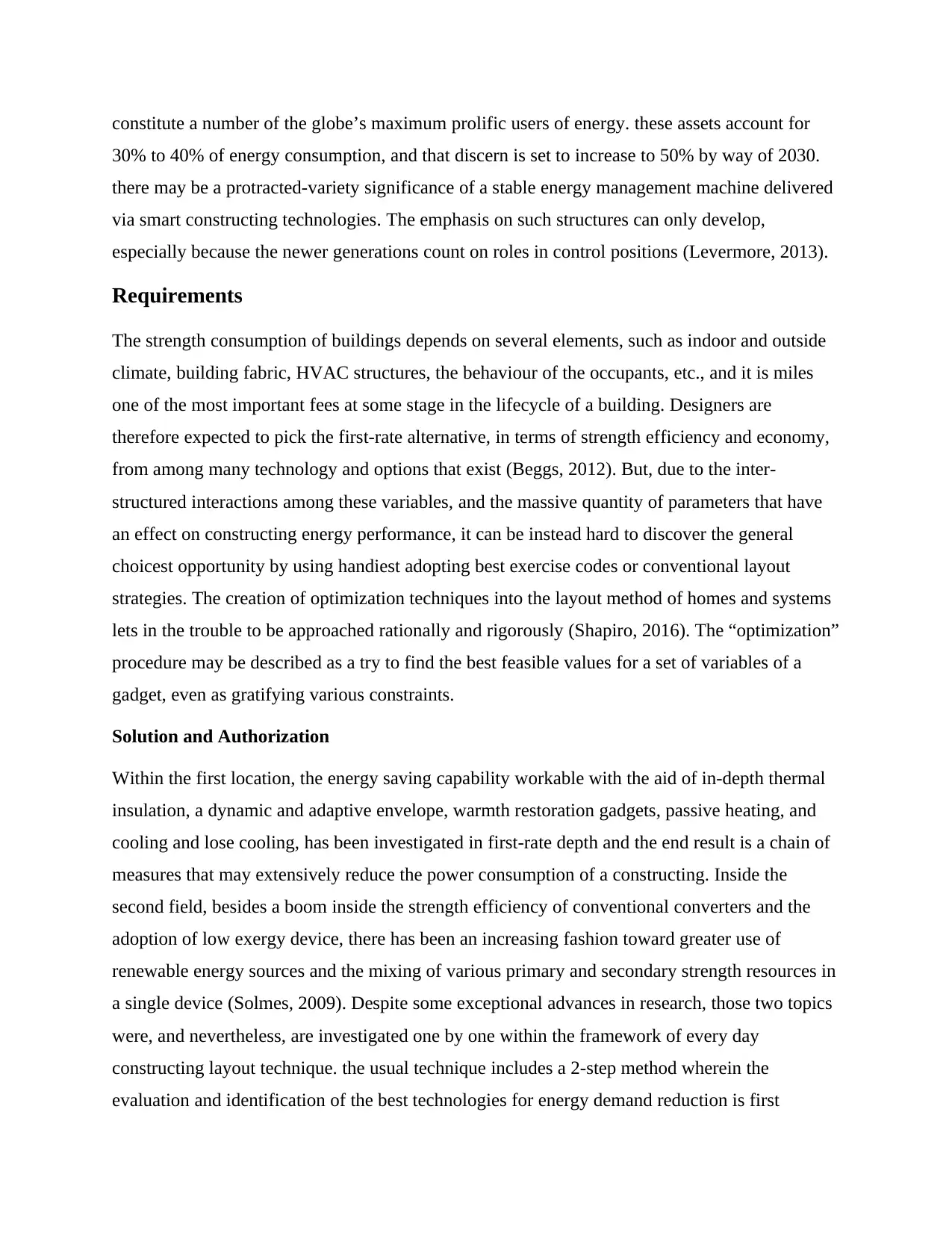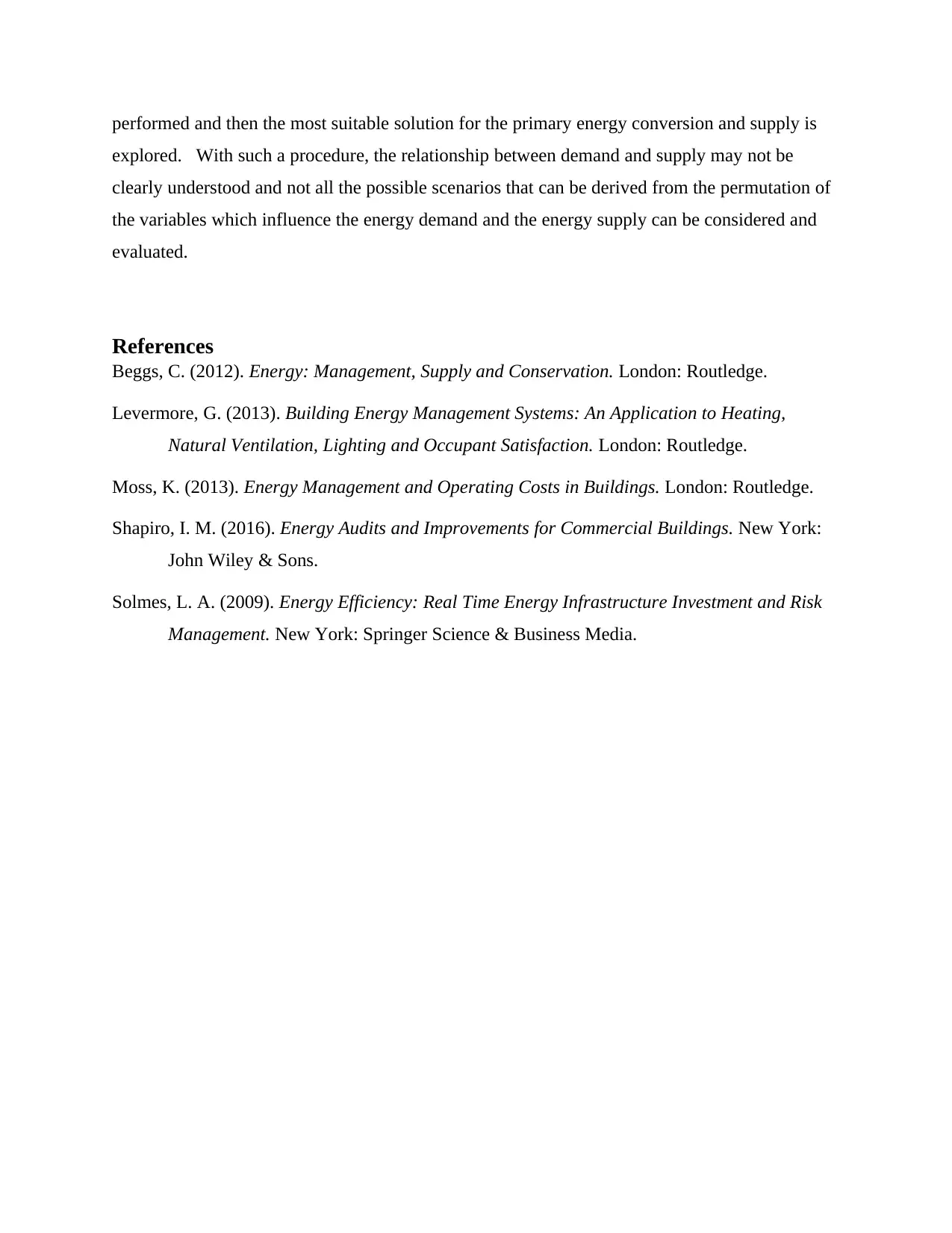Proposal on Energy Management for Buildings - UK Energy Systems
VerifiedAdded on 2022/11/26
|3
|977
|173
Report
AI Summary
This proposal outlines a plan to revolutionize building design and operation in the UK, focusing on integrating advanced offsite manufacturing and digital design. It aims to create "active buildings" through energy integration, storage, and control methods, significantly reducing operational costs and...

Proposal on Energy Management for Buildings
Executive Summary
This proposal is aiming to change the way United Kingdom designs, constructs and operates
buildings and various structures. This will help in realisation of the potential to incorporate
advanced offsite manufacturing with high standard digital designing. Various benefits which will
come by with this proposal include integration of energy integration, storage, and control
methods to create active buildings which will considerably reduce operational cost and meet the
demand in the UK.
This notion gives a residential electricity hub version for a clever multi-provider energy domestic
which includes plug-in hybrid electric automobile, mixed heat and strength, solar panels, and
electric storage machine. The energy hub inputs are strength and natural gasoline that provide
electrical and warmth needs on the output ports. on this concept, an optimization-primarily based
software is proposed to determine the premiere operation mode of the strength hub, to
manipulate the strength consumption of responsive home equipment, to schedule
charging/discharging of plug-in hybrid electric car and the storage gadget, and to coordinate sun
panels operation with family responsive call for in response to day-beforehand time-varying
price lists of power. The objective characteristic is to minimize client payment fee considering
automobile to grid capability. distinct case research is performed to probe the effectiveness of the
proposed method and study the influences of various electrical time-differentiated price lists on
the optimization outcomes on every day and yearly foundation.
History
The various energy customer corporations, it's far recognized that buildings account for nearly
one 33% of the global strength use in a rustic, and therefore make contributions to a super
volume to greenhouse gasoline emissions (Moss, 2013). consequently, the strong overall
performance of homes has to turn out to be a topic this is regularly investigated and discussed by
designers, researchers, policymakers, and applies. it is no marvel that commercial buildings
Executive Summary
This proposal is aiming to change the way United Kingdom designs, constructs and operates
buildings and various structures. This will help in realisation of the potential to incorporate
advanced offsite manufacturing with high standard digital designing. Various benefits which will
come by with this proposal include integration of energy integration, storage, and control
methods to create active buildings which will considerably reduce operational cost and meet the
demand in the UK.
This notion gives a residential electricity hub version for a clever multi-provider energy domestic
which includes plug-in hybrid electric automobile, mixed heat and strength, solar panels, and
electric storage machine. The energy hub inputs are strength and natural gasoline that provide
electrical and warmth needs on the output ports. on this concept, an optimization-primarily based
software is proposed to determine the premiere operation mode of the strength hub, to
manipulate the strength consumption of responsive home equipment, to schedule
charging/discharging of plug-in hybrid electric car and the storage gadget, and to coordinate sun
panels operation with family responsive call for in response to day-beforehand time-varying
price lists of power. The objective characteristic is to minimize client payment fee considering
automobile to grid capability. distinct case research is performed to probe the effectiveness of the
proposed method and study the influences of various electrical time-differentiated price lists on
the optimization outcomes on every day and yearly foundation.
History
The various energy customer corporations, it's far recognized that buildings account for nearly
one 33% of the global strength use in a rustic, and therefore make contributions to a super
volume to greenhouse gasoline emissions (Moss, 2013). consequently, the strong overall
performance of homes has to turn out to be a topic this is regularly investigated and discussed by
designers, researchers, policymakers, and applies. it is no marvel that commercial buildings
Secure Best Marks with AI Grader
Need help grading? Try our AI Grader for instant feedback on your assignments.

constitute a number of the globe’s maximum prolific users of energy. these assets account for
30% to 40% of energy consumption, and that discern is set to increase to 50% by way of 2030.
there may be a protracted-variety significance of a stable energy management machine delivered
via smart constructing technologies. The emphasis on such structures can only develop,
especially because the newer generations count on roles in control positions (Levermore, 2013).
Requirements
The strength consumption of buildings depends on several elements, such as indoor and outside
climate, building fabric, HVAC structures, the behaviour of the occupants, etc., and it is miles
one of the most important fees at some stage in the lifecycle of a building. Designers are
therefore expected to pick the first-rate alternative, in terms of strength efficiency and economy,
from among many technology and options that exist (Beggs, 2012). But, due to the inter-
structured interactions among these variables, and the massive quantity of parameters that have
an effect on constructing energy performance, it can be instead hard to discover the general
choicest opportunity by using handiest adopting best exercise codes or conventional layout
strategies. The creation of optimization techniques into the layout method of homes and systems
lets in the trouble to be approached rationally and rigorously (Shapiro, 2016). The “optimization”
procedure may be described as a try to find the best feasible values for a set of variables of a
gadget, even as gratifying various constraints.
Solution and Authorization
Within the first location, the energy saving capability workable with the aid of in-depth thermal
insulation, a dynamic and adaptive envelope, warmth restoration gadgets, passive heating, and
cooling and lose cooling, has been investigated in first-rate depth and the end result is a chain of
measures that may extensively reduce the power consumption of a constructing. Inside the
second field, besides a boom inside the strength efficiency of conventional converters and the
adoption of low exergy device, there has been an increasing fashion toward greater use of
renewable energy sources and the mixing of various primary and secondary strength resources in
a single device (Solmes, 2009). Despite some exceptional advances in research, those two topics
were, and nevertheless, are investigated one by one within the framework of every day
constructing layout technique. the usual technique includes a 2-step method wherein the
evaluation and identification of the best technologies for energy demand reduction is first
30% to 40% of energy consumption, and that discern is set to increase to 50% by way of 2030.
there may be a protracted-variety significance of a stable energy management machine delivered
via smart constructing technologies. The emphasis on such structures can only develop,
especially because the newer generations count on roles in control positions (Levermore, 2013).
Requirements
The strength consumption of buildings depends on several elements, such as indoor and outside
climate, building fabric, HVAC structures, the behaviour of the occupants, etc., and it is miles
one of the most important fees at some stage in the lifecycle of a building. Designers are
therefore expected to pick the first-rate alternative, in terms of strength efficiency and economy,
from among many technology and options that exist (Beggs, 2012). But, due to the inter-
structured interactions among these variables, and the massive quantity of parameters that have
an effect on constructing energy performance, it can be instead hard to discover the general
choicest opportunity by using handiest adopting best exercise codes or conventional layout
strategies. The creation of optimization techniques into the layout method of homes and systems
lets in the trouble to be approached rationally and rigorously (Shapiro, 2016). The “optimization”
procedure may be described as a try to find the best feasible values for a set of variables of a
gadget, even as gratifying various constraints.
Solution and Authorization
Within the first location, the energy saving capability workable with the aid of in-depth thermal
insulation, a dynamic and adaptive envelope, warmth restoration gadgets, passive heating, and
cooling and lose cooling, has been investigated in first-rate depth and the end result is a chain of
measures that may extensively reduce the power consumption of a constructing. Inside the
second field, besides a boom inside the strength efficiency of conventional converters and the
adoption of low exergy device, there has been an increasing fashion toward greater use of
renewable energy sources and the mixing of various primary and secondary strength resources in
a single device (Solmes, 2009). Despite some exceptional advances in research, those two topics
were, and nevertheless, are investigated one by one within the framework of every day
constructing layout technique. the usual technique includes a 2-step method wherein the
evaluation and identification of the best technologies for energy demand reduction is first

performed and then the most suitable solution for the primary energy conversion and supply is
explored. With such a procedure, the relationship between demand and supply may not be
clearly understood and not all the possible scenarios that can be derived from the permutation of
the variables which influence the energy demand and the energy supply can be considered and
evaluated.
References
Beggs, C. (2012). Energy: Management, Supply and Conservation. London: Routledge.
Levermore, G. (2013). Building Energy Management Systems: An Application to Heating,
Natural Ventilation, Lighting and Occupant Satisfaction. London: Routledge.
Moss, K. (2013). Energy Management and Operating Costs in Buildings. London: Routledge.
Shapiro, I. M. (2016). Energy Audits and Improvements for Commercial Buildings. New York:
John Wiley & Sons.
Solmes, L. A. (2009). Energy Efficiency: Real Time Energy Infrastructure Investment and Risk
Management. New York: Springer Science & Business Media.
explored. With such a procedure, the relationship between demand and supply may not be
clearly understood and not all the possible scenarios that can be derived from the permutation of
the variables which influence the energy demand and the energy supply can be considered and
evaluated.
References
Beggs, C. (2012). Energy: Management, Supply and Conservation. London: Routledge.
Levermore, G. (2013). Building Energy Management Systems: An Application to Heating,
Natural Ventilation, Lighting and Occupant Satisfaction. London: Routledge.
Moss, K. (2013). Energy Management and Operating Costs in Buildings. London: Routledge.
Shapiro, I. M. (2016). Energy Audits and Improvements for Commercial Buildings. New York:
John Wiley & Sons.
Solmes, L. A. (2009). Energy Efficiency: Real Time Energy Infrastructure Investment and Risk
Management. New York: Springer Science & Business Media.
1 out of 3
Your All-in-One AI-Powered Toolkit for Academic Success.
+13062052269
info@desklib.com
Available 24*7 on WhatsApp / Email
![[object Object]](/_next/static/media/star-bottom.7253800d.svg)
Unlock your academic potential
© 2024 | Zucol Services PVT LTD | All rights reserved.